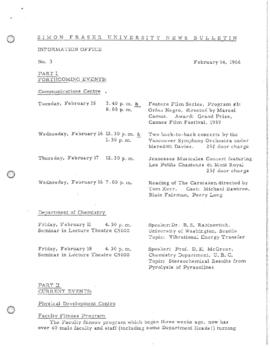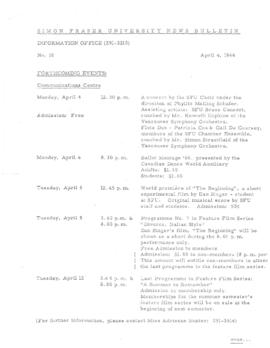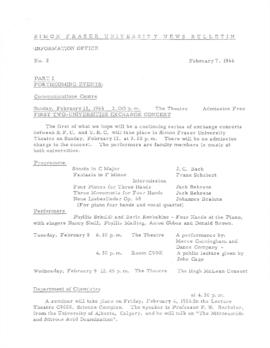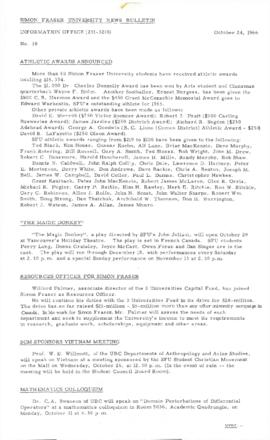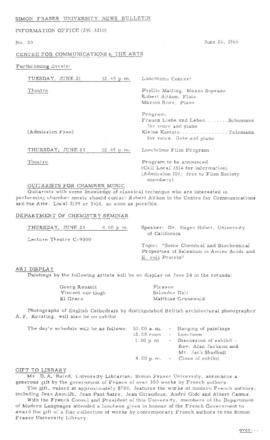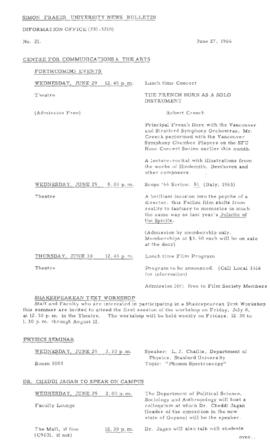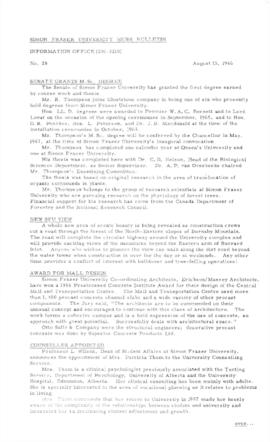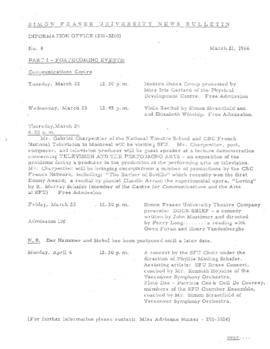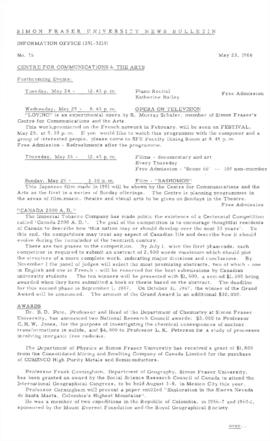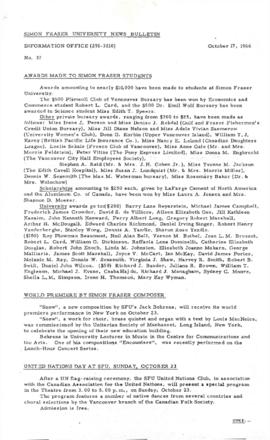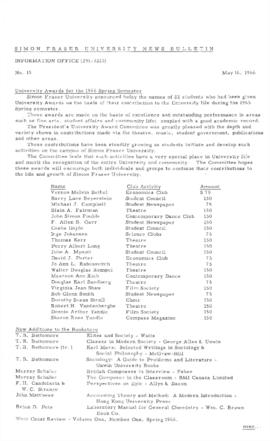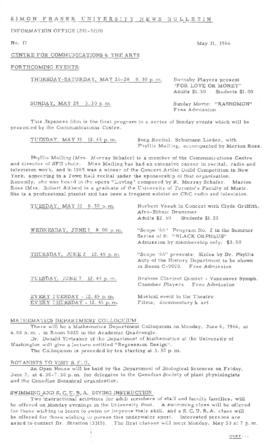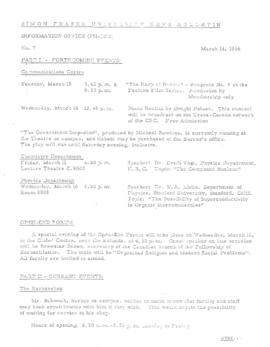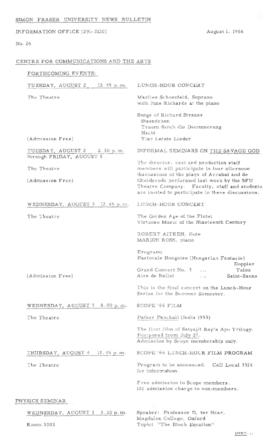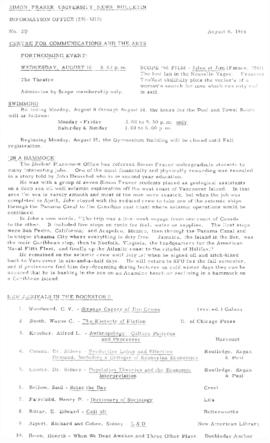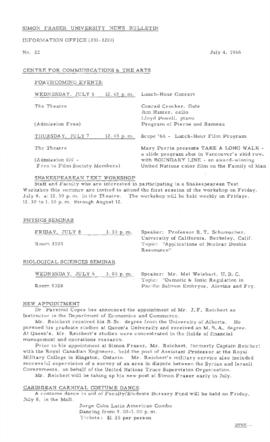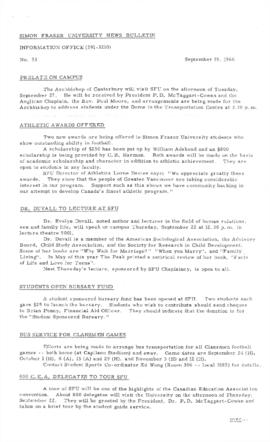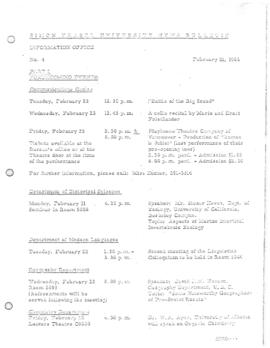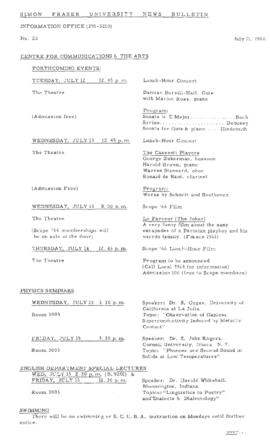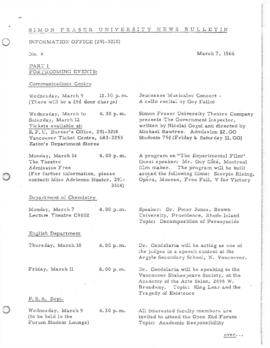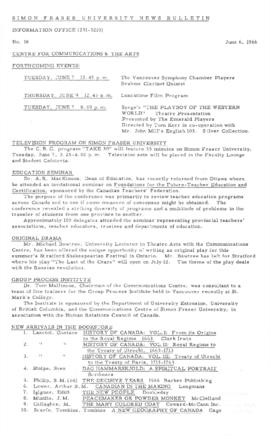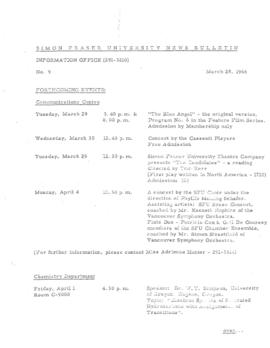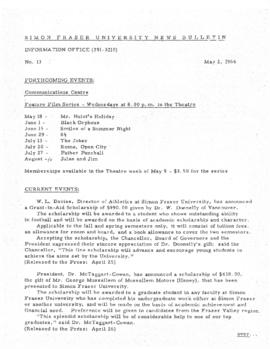Title and statement of responsibility area
Title proper
University Communications and Marketing fonds
General material designation
- Photographic materials
- Textual records
- Records in electronic form (digitized)
Parallel title
Other title information
Title statements of responsibility
Title notes
- Source of title proper: Title based on the name of the records creator.
- Variations in title: Previous titles – Media and Public Relations Office fonds (1998-2016); University Communications fonds (2016-2022).
Level of description
Fonds
Reference code
Edition area
Edition statement
Edition statement of responsibility
Class of material specific details area
Statement of scale (cartographic)
Statement of projection (cartographic)
Statement of coordinates (cartographic)
Statement of scale (architectural)
Issuing jurisdiction and denomination (philatelic)
Dates of creation area
Date(s)
-
1964 - 2019 (Creation)
- Creator
- University Communications and Marketing
Physical description area
Physical description
Paper and analog originals:
2.7 m of textual records
ca. 3300 photographs : contact sheets
ca. 66000 photographs : negatives
Digitized copies:
ca. 630 photographs : contact sheets (ca. 200 GB, pdf, tiff)
Born-digital records:
10.6 GB of textual records (pdf)
Publisher's series area
Title proper of publisher's series
Parallel titles of publisher's series
Other title information of publisher's series
Statement of responsibility relating to publisher's series
Numbering within publisher's series
Note on publisher's series
Archival description area
Name of creator
Administrative history
University Communications and Marketing has overall responsibility for strategic communications at Simon Fraser University. At the time of writing (Feb 2022), its responsibilities included communications planning for internal and external audiences, management of media relations and stakeholder outreach, university website design and SFU visual brand guidelines and standards, and the creation of media productions (photographs, video, online, print) that support the university's vision and priorities.
Interest in SFU grew rapidly after the university opened its doors in 1965. To provide information to the public, SFU first relied upon the Executive Assistant to the President. This position was held for the first two semesters by R. J. Watts, an instructor in the English Department, and, in an acting capacity during the summer of 1966, by E. N. Turner, a graduate student from the same department. In August 1966 the University hired Dennis Roberts, an experienced newsman and public relations director as its first full-time information officer. Roberts wrote news releases, prepared brochures, began a speakers' bureau to address off-campus groups, and started a campus tour program. He was assisted by a secretary and student tour guides. Because there were no vice-presidents or other senior officers in those years, the Information Officer also acted as a special assistant to President Patrick McTaggart-Cowan. Roberts wrote many of his speeches, and McTaggart-Cowan even deputized Roberts as speaker at several meetings.
With increased funding, the Information Office gradually expanded its scope. The Director hired an information assistant, and, in 1972, changed the department's name to University News Service (UNS) to better describe its functions and to avoid confusion with the term "information systems." In addition to press releases, UNS produced a series of publications – SFU Week, Comment, and Takkali. Roberts also took on responsibility for the SFU Pipe and Drum Band for eight years. After his retirement from SFU in 1982, the university made an arrangement with the Port Moody Pipe Band to perform as the SFU's band. In his spare time, Roberts produced SFU-oriented greeting cards and cartoons for faculty, students and staff.
Roberts' long-time assistant Ken Mennell succeeded him as Director from 1982-1998, followed by Kathryn Aberle (1998-2006), and Don MacLachlan (2006-2013). During this period, the office was renamed Media and Public Relations (MPR, 1998-2006), then Public Affairs and Media Relations (PAMR, 2006-2013). A substantial reorganization of the portfolio occurred in 2014 with the establishment of SFU Communications and Marketing. This brought into the portfolio responsibility for brand management, as well as Creative Studio, a unit with a long tradition of education media production at SFU. Prior to the merger, Creative Studio was a unit in the VP Academic's portfolio, mostly tasked with the creation of educational media, and was itself the successor of a number of earlier incarnations with similar functions: the Audio-Visual Centre (1967-1981), the Instructional Media Centre (IMC, 1981-2000), the Learning and Instructional Development Centre (LIDC, 2000-2011), and the Teaching and Learning Centre (TLC, 2011-2013). Other names for this unit included Media Services, Media Design, and Creative Services. Since the 2014 reorganization, Communications and Marketing has been headed by an External Director, first Sarah Temple (2014-2016), then Kristin Linklater (2016–).
For most of its history, University Communications and Marketing and its predecessors have reported to either the President (1966-1971 and 1976-1981) or to the senior executive (typically a Vice-President) responsible for external relations. For a visual presentation of the unit's administrative history, see Appendix A in the hardcopy and pdf versions of the F-61 finding aid.
Names changes:
- Information Office (1966-1972)
- University News Service (1972-1982)
- Media and Public Relations (1982-2006)
- Public Affairs and Media Relations (2006-2014)
- University Communications and Marketing (2014–)
Chief officers:
- Dennis Roberts, Information Officer (1966-1972), Director (1972-1982).
- Ken Mennell, Director (1982-1998)
- Kathryn Aberle, Director (1998-2006)
- Don MacLachlan, Director (2006-2013)
- Sarah Temple, Executive Director (2014-2016)
- Kristin Linklater, Executive Director (2016–)
Custodial history
The records were in the continuous custody and control of University Communications and Marketing and its predecessors prior to their transfer to Archives. The department has made numerous transfers to the Archives from the 1980s on.
Scope and content
Fonds consists of records made or received by University Communications and Marketing and its predecessors.
Activities and topics documented include the establishment, organization and operation of the unit; photography of SFU people, places and events for campus publications; provision of information to the public; organization of special events; liaison with other units in the University; and the production of press releases, brochures, and on-going publications.
Records types include correspondence, minutes, reports, proposals, and working papers; photographs, including negatives and contact sheets; university press releases and publications; and articles and other reference materials relating to SFU.
The fonds is arranged into seven series:
Notes area
Physical condition
Immediate source of acquisition
Arrangement
The arrangement of the fonds into series is broadly based on the original order in which the records were created and maintained by the creating department. Series 1 (Photographic material) was reorganized by the archivist in 2022 with the incorporation of digitized copies of the original contact sheets and import of legacy photo index data. Three sub-series (1-1, 1-2, and 1-3) were retired and replaced by a single new sub-series (1-4). See the description for for F-61-1, Arrangement note.
Language of material
- English
Script of material
Location of originals
Availability of other formats
The Archives has begun digitizing materials from parts of the fonds: early SFU newsletters / bulletins (1966-1967, series 4) and photographic contact sheets (1971-1979, series 1). See those series descriptions for details on file formats. Digitization work on the contact sheets remains in progress (as of Feb 2022).
Restrictions on access
The records of University Communications and Marketing are university records subject to British Columbia's Freedom of Information and Protection of Privacy Act (FIPPA). Access restrictions may apply to records containing personal information or confidential information (e.g. legal advice). Some series represent materials that were produced for public dissemination, and these are generally open, e.g. photographs (series 1), publications (series 4), and press releases (series 5-1). Other files throughout the fonds are marked "pending review" and must be reviewed for clearance by an archivist prior to release. See the file lists and consult the reference archivist for more information.
Terms governing use, reproduction, and publication
Most records in the fonds are subject to copyright, but copyright ownership is mixed.
Copyright in records authored by SFU employees belongs to SFU. The Archives provides access to these materials under a Creative Commons Attribution-NonCommercial license (CC BY-NC). Users are free to copy, share and adapt the materials as they wish provided they credit SFU as the creator, indicate any changes they have made, and use the works for a non-commercial purpose. All requests for commercial use should be made in writing to SFU Archives.
The fonds also includes some copyright-protected materials for which SFU does not own copyright (e.g. incoming records received that were authored by non-SFU third parties). For these materials, the Archives makes copies available for private study or research purposes under the fair dealing provisions of Canada's Copyright Act. Use for any other purpose may require the permission of the copyright owner. SFU Archives can assist researchers in attempting to identify copyright owners, but it is users' responsibility to contact owners and secure any permissions.
See individual series descriptions for more information about the application of copyright to specific sets of records.
Finding aids
The hardcopy and pdf versions of this finding aid include two appendices: Appendix A, Administrative History Data (visual chart); and Appendix B: How to Request Copies of Photographs. An index to the photographs of series 1 is available offline. The Archives is working to incorporate this data into the current finding aid descriptions; see series 1, note on Finding aids for more detail.
Generated finding aid
Associated materials
For other materials relating to the first head of the department, see the Dennis Roberts fonds (F-161); link below.
Creative Studio was brought into University Communications and Marketing in 2014 and its records now form part of this fonds. However, Creative Studio is the direct successor of the Learning and Instructional Development Centre (LIDC, 2001-2010) and its predecessors, the Instructional Media Centre (IMC, 1981-2001) and the Audio-Visual Centre (1967-1981) before that. For the records of these latter departments, see the Learning and Instructional Development Centre fonds (F-18); link below.
Accruals
Further accruals are expected. Digitization of contact sheets remains in progress – 1971-1979 has been completed, and the years 1980-2000 will be uploaded when ready. Additional transfers from the department have been accessioned but not yet processed. As of Feb 2022, this includes ca. 12 m. of unprocessed boxed records, including a run of "people files" (1965-2008), administrative records, photographic materials, and audio-visual products. The Archives received several transfers of born-digital materials in 2020-21 that have not yet been processed, including 4.6 GB of media releases and ca. 6 TB of photographs.
Physical description
Photographs and digitized materials are in series 1. The figure for total photographs (33000) is based on an estimate of 20 images per contact sheet.
The born-digital media is located in series 5-3, Web media releases. It comprises ca. 3500 press releases in pdf format. The total volume (10.6 GB) includes originals, preservation copies and access copies.
Alternative identifier(s)
Standard number area
Standard number
Access points
Subject access points
Place access points
Name access points
- Aberle, Kathryn (Subject)
- Mennell, Ken (Subject)
- Roberts, Dennis (Subject)
- MacLachlan, Don (Subject)
- Temple, Sarah (Subject)
Genre access points
Control area
Description record identifier
Institution identifier
Rules or conventions
RAD July 2008 edition
Status
Revised
Level of detail
Full
Dates of creation, revision and deletion
Revision history:
- November 1998: first arrangement and description, finding aid prepared by Ian Forsyth, Frances Fournier, Enid Britt, Judith Thiessen.
- August 2001: finding aid updated (Frances Fournier, Enid Britt, Kelly Spray).
- December 2004: accruals processed and description revised (Frances Fournier).
- January 2007: accruals processed and description revised (Lisa Beitel)
- August 2016: name of fonds changed to reflect latest accruals (Richard Dancy).
- February 2022: administrative history and fonds description revised / updated; series 1 arrangement and description revised (Richard Dancy)
Language of description
- English


